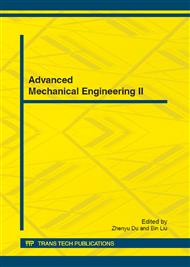p.190
p.196
p.201
p.207
p.211
p.217
p.222
p.227
p.233
Workspace Analysis and Calculation for the Manipulator of a Explosive-Handling Robot in Mine
Abstract:
The volume of workspace is one of the most important parameters to evaluate the flexibility of a robot. Monte Carlo Method and adaptive-divided mesh method were applied to analyze the workspace of the manipulator of a explosive-handling robot in mine. Firstly, the kinematical model of the manipulator was taken forward based on its main structure. Then, its kinematics analysis was given. Based on them, the manipulator’s workspace was analyzed by Monte Carlo Method and the cloud picture was completed. At last, the ‘Adaptive-divided Mesh Method’ was brought forward and the volume of the workspace was calculated with it. The result shows that the workspace’s volume is large enough and the working points in the workspace of the explosive-handling manipulator were distributed compactly and uniformly, which can satisfy the requirements with high efficiency.
Info:
Periodical:
Pages:
211-216
Citation:
Online since:
July 2012
Authors:
Price:
Сopyright:
© 2012 Trans Tech Publications Ltd. All Rights Reserved
Share:
Citation:


